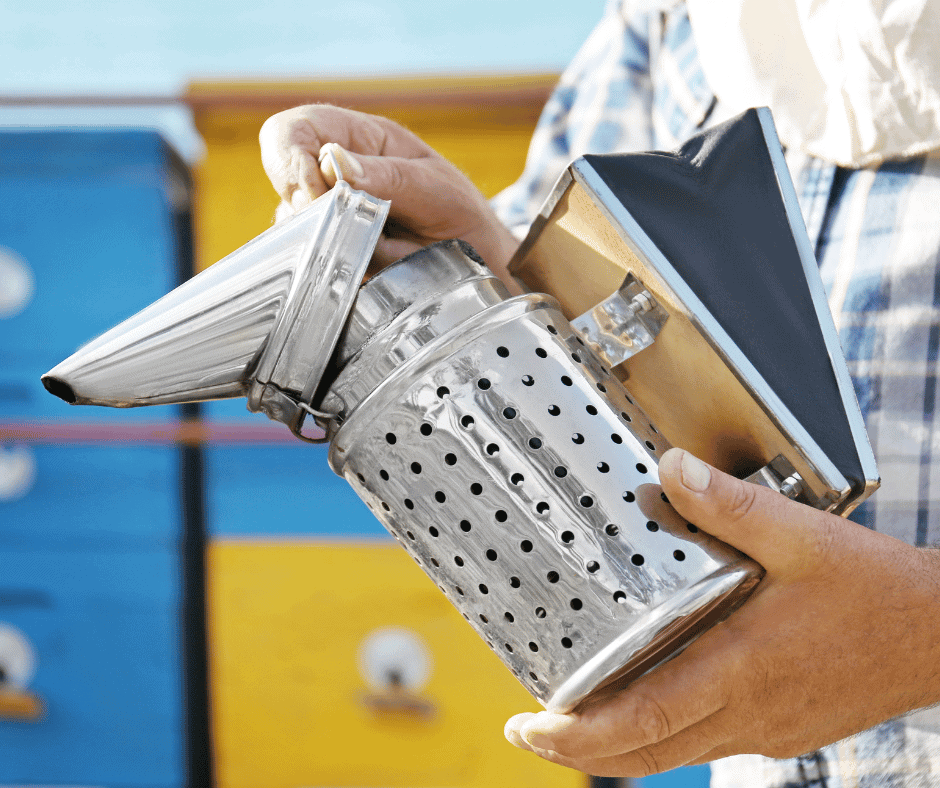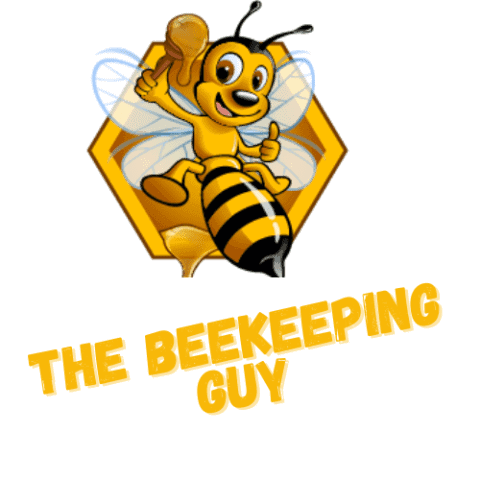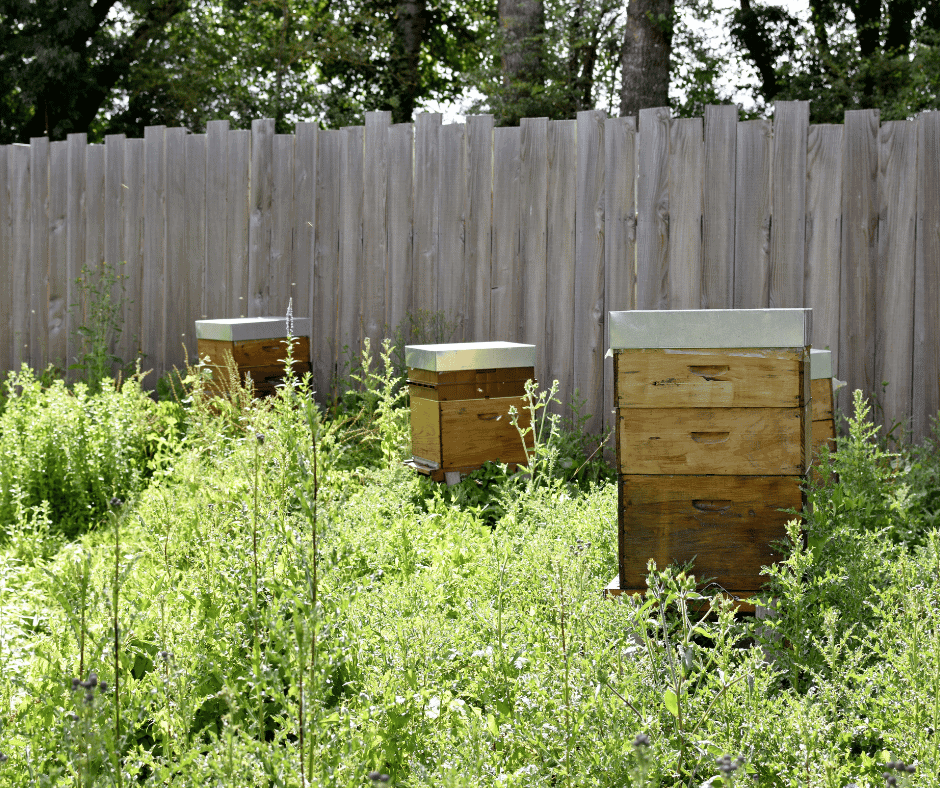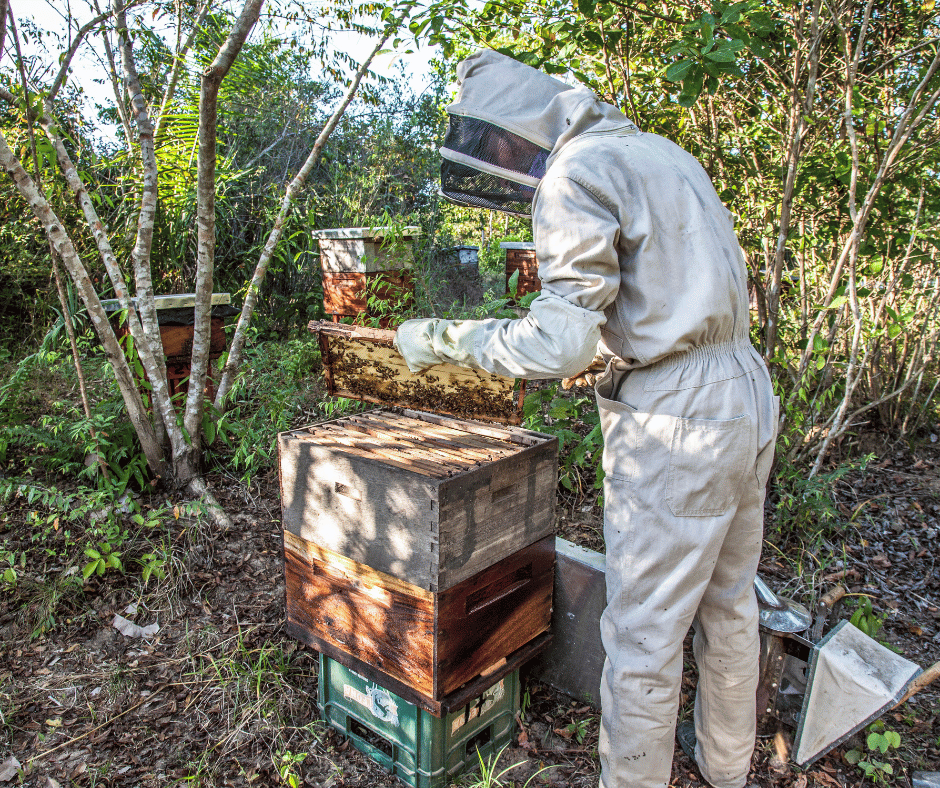
Smoke has been used for centuries to keep bees calm and make it easier for beekeepers to work without fear of getting stung. In this article, we will explore how smoke can help protect both the bees and those who interact with them from harm. We’ll also discuss some of the potential dangers associated with using smoke on bees, so readers can weigh up the risks before attempting any type of interaction themselves.
Finally, we’ll provide practical tips on how to use smoke safely and effectively if you do decide to try your hand at beekeeping or interacting with wild honeybees. So join us as we investigate why exactly beekeepers use smoke!
Table of Contents
Historical Uses Of Smoke In Beekeeping
Beekeepers have been using smoke to handle their hives for centuries. Bee smokers are a type of tool that produces cool, dense smoke used to calm the bees and make them easier to work with.
Before modern beekeeping techniques were available, this was the only way to interact with honeybees safely. The smoke spray is also used by some beekeepers when they need to move the hive or open it up without having too much disruption from the bees.

Smoke has an interesting effect on bees; it masks alarm pheromones which bees naturally emit when they sense danger. This helps keep them tranquil while the beekeeper works around them and inspects the hive’s interior.
It also disrupts communication between worker bees so they can’t alert each other about potential threats in their area. As such, smoke proves invaluable for managing hives without compromising safety.
This allows them to better anticipate possible reactions from their colony and respond accordingly. With practice and patience, these precautions ensure both human and insect safety…but what effect does smoke have on the bees themselves?
5 Of The Best Smokers
[amazon box=”B009Z1SLQK,B01BKU8ULE,B01M4SDUFM,B09XK94HNC,B07Q1X2NBJ” grid=”5″]
Reactions Of Bees To Smoke
Beekeepers use smoke to calm the bees and get them out of their hives. Smoking bees out allows beekeepers to work with a more docile population, making it easier for them to extract honey or inspect the hive without fear of getting stung.
When smoking bees out, they become confused by the scent of the smoke which masks any alarm pheromones that may be present in normal circumstances. This confusion causes them to remain still instead of flying away from danger or attacking intruders as a defensive measure.
The smoke also blocks their breathing tubes and reduces oxygen uptake, causing further disorientation.
Smoke has been used as an effective tool for thousands of years when working with bees, providing a safe environment for both beekeepers and bees alike.
It is important to note that not all types of smoke are suitable for this purpose – certain scents can cause adverse reactions in bees such as increasing their aggression levels rather than calming them down. As such, choosing the right type of smoke is essential before attempting to control or move a colony of bees.
By understanding how smoke affects the nervous system of bees, beekeepers can ensure they have chosen an appropriate type while remaining mindful that too much exposure could lead to injury or death among the colony’s members.
How Smoke Affects The Nervous System Of Bees

When beekeepers use a bee hive smoker, it sends out smoke that has an effect on the nervous system of bees. The smoke triggers receptors in their antennae and mouthparts which causes them to react by calming down. This is why does smoke calms bees; it acts like a sedative for them by causing them to enter into a state of inactivity or sleep-like stillness.
This reaction can be incredibly helpful for beekeepers who are trying to gain access to honeycomb frames without the risk of being stung. Bees will become docile when exposed to smoke, allowing the beekeeper to safely open up the hive and extract what they need without fear of getting hurt.
The effects of this exposure generally only last while there is still smoke present in the air. Once the amount of smoke dissipates, so do its effects on the bees’ behavior and they will go back to their normal routine as if nothing happened at all.
With this knowledge in mind, it’s easy to understand why using small amounts of smoke is such a useful tool for many modern-day apiarists.
However, even though smoke may have calming effects on bees, understanding its advantages can help make sure that it is used properly in order to protect both humans and pollinators alike.
Advantages Of Using Smoke On Bees
As we have said, smoke is often used to keep honey bees calm and compliant, allowing the beekeeper to manage hives without disruption or risk of stings. There are several reasons why beekeepers use smoke when tending their hives: it masks alarm pheromones, it distracts the bees from focusing on the beekeeper as a threat, and it offers an easy way for them to control hive populations.
Smoke has been found to be an invaluable tool in helping beekeepers safely access their hives and work within them without fear of being attacked by defensive bees.
In addition, smoking not only helps with hive management but provides protection against mites and other pests which could potentially harm the hive’s inhabitants.
The benefits of using smoke when managing beehives cannot be understated. Beekeepers rely heavily upon this technique in order to ensure the safe handling of their colonies while still providing the adequate care and attention they need.
With the right smoker device and proper application techniques, any beekeeper can easily master this method and benefit from its many advantages – making caring for their hives much easier.
Types Of Smokers Used By Beekeepers
Smoke is a critical tool for beekeepers in managing their colonies. To be effective, the smoke must come from an appropriate source and be applied correctly to ensure safety. There are several types of smokers used by beekeepers that provide different levels of heat and smoke.
The traditional smoker consists of a metal cylinder with bellows attached to one side. This type of smoker uses natural fuels such as dried grass or pine needles which generate both heat and dense white smoke when lit.

A variation of this type contains pre-packed fuel tablets made from paraffin wax, beeswax, sawdust, and other materials designed to provide consistent plumes of cool grey/blue smoke without producing too much heat.
Modern electric-powered smokers offer more control over the amount and intensity of the smoke produced. These usually consist of a battery-operated fan, so you don’t need to worry about using bellows. And they normally operate on 4 small batteries.

No matter what type of smoker is chosen for use around bees it’s important that the user understands how to use it appropriately for maximum effectiveness while minimizing any risks associated with its application.
To do this it’s essential that beekeepers familiarize themselves with the various components and settings available on each device before attempting to use them around their hives.
With knowledge comes confidence and safety! Knowing how to manage your equipment properly allows you to focus more on providing excellent care for your colony rather than worrying about potential dangers posed by improper usage.
How To Use A Smoker Appropriately
First and foremost, it’s important to understand how using smoke affects bees. Smoke will cause the bees’ natural instincts to kick into gear – they’ll instinctively think there is a fire nearby, so they will start consuming honey stores in preparation for evacuation.
By doing this, the amount of pheromones released by guard bees is reduced; thus allowing beekeepers access without provoking too much agitation or risk of stinging.
As such, it’s important not to over-smoke the hive – otherwise, you may end up killing off your own colony!

Smokers should also be lit slowly and carefully, as different fuels have varying levels of burn intensity which can affect how well the smoke works on calming down the bees.
Generally speaking, softwood shavings are best suited for creating white plumes of mild smoke when burned at low temperatures; whereas hardwoods tend to create greater volumes of thicker black smoke – both types can work depending on preference but careful control is needed here to avoid stressing out your colonies unnecessarily.
With proper care taken when handling smokers around hives, peace between man and insect reigns supreme within our shared environment!
Video On Using A Bee Smoker
Potential Disadvantages Of Using Smoke On Bees
Beehive smokers are commonly used by beekeepers to calm and control the behavior of honeybees. By puffing smoke into a beehive, they can disrupt bees’ natural defense mechanisms, allowing them to work with the hive more safely. However, using smoke on bees does come with some potential risks that need to be considered.
The first risk is direct physical harm to the bee’s respiratory system caused by the inhalation of smoke particles.
The heat generated by burning fuel in a smoker can cause localized damage to the sensitive cells lining their tracheal tubes, which could lead to injury or death if too much exposure occurs.
Additionally, there is also evidence that suggests smoke may irritate and weaken a bee’s immune system over time – making it easier for viruses and other diseases to spread between hives.
Finally, even when administered correctly, stress hormones released during smoking can have an adverse effect on colony health and productivity.
Bees exposed to prolonged periods of smoke may produce smaller amounts of honey than normal due to reduced flight activity and disruption in grooming behaviors necessary for keeping healthy brood cells sealed against pests or pathogens.
Considering these possible drawbacks, it is important for beekeepers to take proactive steps toward minimizing any potential risks posed by using smoke on bees.
Tips For Minimizing Risk To Bees From Smoke Exposure
To ensure the safety of bees, beekeepers should take certain precautions when using smoke. It’s important to understand that although smoke can be used as a tool for beekeeping, it also carries risks if not handled properly. Here are four tips for minimizing the risk to bees from smoke exposure:
- Use only short bursts of smoker fuel or spray and never overfill the smoker.
- Place the smoker away from hive entrances in order to reduce inhalation by entering workers.
- Smoke lightly and make sure that there is adequate ventilation so that fumes don’t accumulate around the hives.
- Monitor how your bees respond to smoke usage; if they show signs of distress, stop smoking immediately.
Taking these simple steps will help create a safe environment for both you and your bees while still allowing you to get the job done effectively. With this knowledge in mind, we can now move on to considering alternatives to using smoke in beekeeping.
Alternatives To Using Smoke In Beekeeping
Beekeepers use smoke when managing their hives in order to calm the bees and make them less likely to sting. But what does a smoker do to bees? Smoke can cause respiratory irritation, dehydration, disorientation, and confusion in bees. In addition, there is a risk of smoke inhalation that could harm the beekeeper as well. Therefore, it’s important for beekeepers to take safety precautions when using a smoker.
Fortunately, there are alternatives to using smoke in beekeeping such as essential oils like eucalyptus or lemongrass oil which can be used instead of smoke. These alternative methods offer many benefits over traditional methods including providing better air quality for both the bees and the beekeeper while still calming down the hive so they don’t become aggressive. Additionally, these products are easier on your wallet than buying a smoker!
In regards to safety, essential oils have fewer risks associated with their use compared to smoking because they remain close to the ground where they won’t be inhaled by either humans or insects. This makes them much safer for those working near an open hive.
So if you’re looking for a more efficient and safer option for keeping your hives calm during inspections or maintenance work then consider switching from traditional smoking techniques to essential oil-based solutions. It may provide just enough protection for both yourself and your colony without risking any damage from exposure to too much smoke.
But what about Safety Precautions when using a smoker, I hear you ask. Next, we will help ensure everyone’s well-being around the hive area – human and insect alike!
Safety Precautions For Using A Smoker
While a smoker is an efficient tool for helping keep beekeeping safe, there are still some important safety precautions that should be taken when using one.
| Precaution | Safety Tip |
|---|---|
| Wear protective clothing | Put on the appropriate attire – long sleeves, gloves, boots, and veil or hood |
| Fire safety | Check wind direction before lighting and make sure your hive area is free of flammable material |
| Smoke inhalation risks | Avoid breathing in too much smoke by taking breaks throughout the process of smoking hives |
The most effective way to avoid potential injury while using a smoker is through proper preparation and training. Taking time to understand how fire behaves around different materials can help prevent accidents. Make sure you read any instructions provided with your smoker carefully before use!
It’s also important to consider environmental impacts when using smokers. Excessive amounts of smoke can reduce visibility and cause air pollution in surrounding areas which may negatively affect our pollinator friends.
To ensure responsible use of smokers, it’s best to take into account local regulations as well as best practices for environmentally-conscious use. Moving forward we’ll explore these best practices in greater detail.
Best Practices For Environmentally-Conscious Use Of Smokers
Smoke is a vital tool for beekeepers and provides many benefits to keepers, bees, and the overall environment. To ensure its safe use, some best practices should be kept in mind when using smoke on bees.
First, it’s important to make sure that the smoker being used is clean and free of any debris or old fuel which could cause an unintended fire hazard. Smokers should also always be operated outside with adequate ventilation so as not to expose either humans or bees to excess fumes or smoke. Any spilled fuel should be cleaned up immediately and disposed of responsibly.
Second, beekeepers should strive to use only sustainable materials such as twigs, leaves, pine needles, or wood chips rather than processed fuels like charcoal briquettes or other petroleum-based products.
This helps minimize the environmental impact of the smoker while still providing effective results for keeping the bees calm. Additionally, these natural materials can often be found locally reducing the need to purchase new goods from unsustainable sources.
Finally, it’s essential that all smokers are handled with care so they don’t become damaged over time due to improper storage and cleaning techniques.
Keeping smokers well-maintained will help them last longer and provide better results for safer handling of bees year after year. With these simple precautions in place, beekeepers can rest assured knowing that their use of smoke won’t negatively impact the environment but instead benefit both themselves and their hives.
By understanding how best to handle smokers safely and sustainably everyone involved stands to gain much more than just peace of mind – they’ll secure healthier environments too!
Common Misconceptions About Smoking Bees
Many people have misconceptions about beekeepers using smoke when tending to their hives. Here are a few of the most common myths:
- Smoke harms bees: This couldn’t be farther from the truth! In fact, it’s quite the opposite – smoke is used to soothe them and keep them calm while beekeepers work on their hives.
- The smell scares away predators: While this isn’t entirely true either, some predators may be deterred by it if they’re unfamiliar with its scent.
- It stops bees from stinging: Smoked does not prevent or inhibit a bee’s ability to sting – that is an instinctual response based on defense mechanisms; however, it does put them at ease enough so that beekeepers can safely inspect their colonies without fear of being stung.
By masking alarm pheromones released by guard bees, smoking helps make sure all bees remain calm during the inspection process, allowing the beekeeper to do what needs to be done in safety and comfort for both themselves and the hive’s inhabitants. #
As long as proper safety protocols are observed and procedures are followed correctly, there should be no worry of harm coming to anyone involved in caring for these vital creatures.
Conclusion
The primary purpose of smoke when it comes to bees is to mask the pheromones they release when they feel threatened. When this scent reaches other worker bees, it triggers them into a defensive state called ‘bearding’ which can make management difficult.
By using smoke around the hive entrance and inside the colony, beekeepers can disguise these alarm signals and keep the insects calm while working with them.
Additionally, smoke helps reduce stress levels in colonies being moved or disturbed by humans. The calming effects of smoke on bees make it easier for beekeepers to relocate hives without causing too much disruption or distress among its members – allowing successful management of large populations without risking injury or damage to people or property.
For these reasons, beekeepers must always remember how essential this ancient technique truly is!



